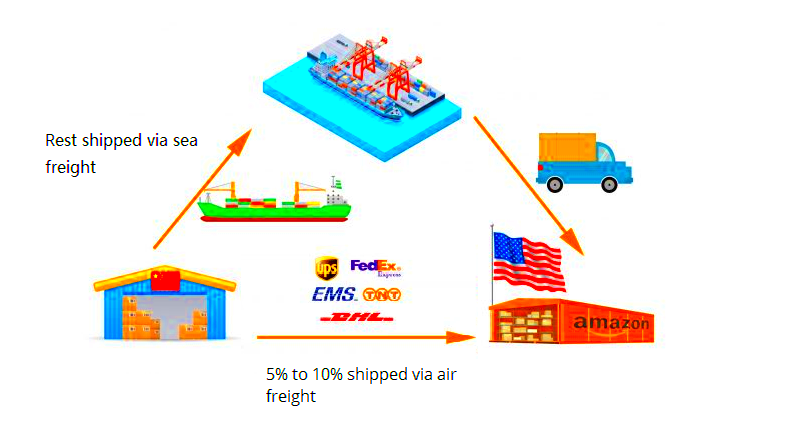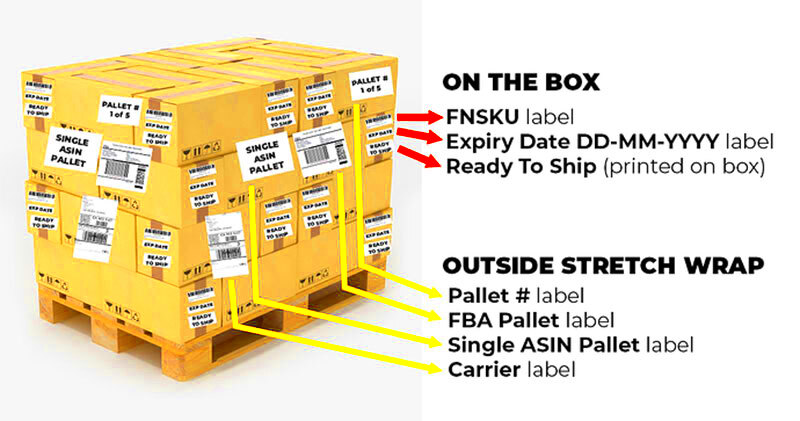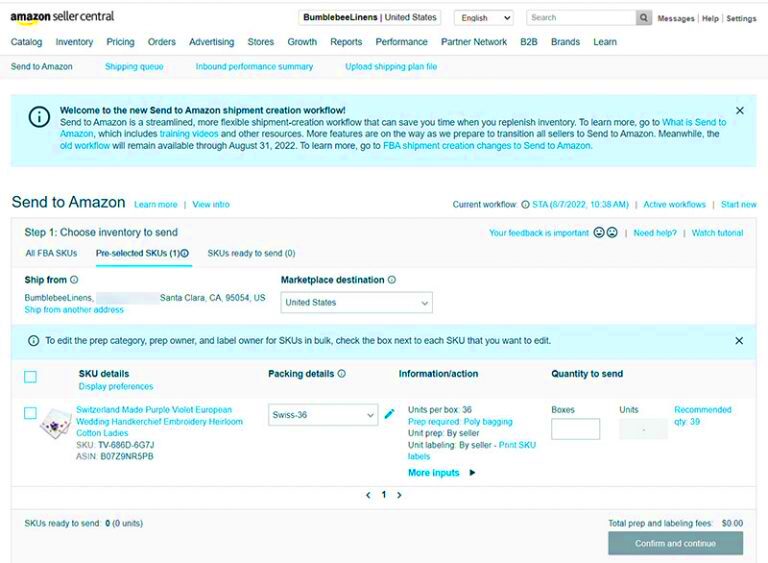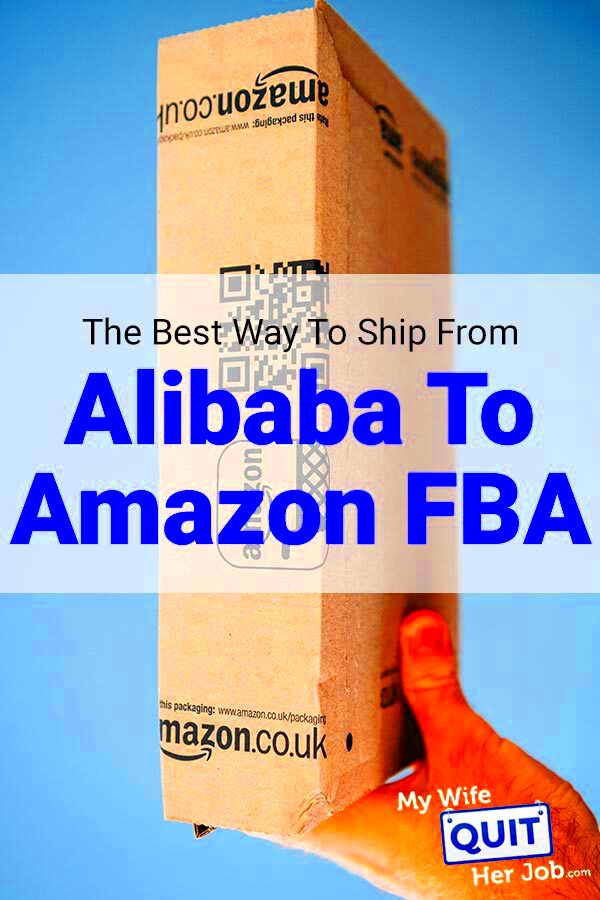Imagine embarking on an adventure in the realm of commerce. You're an aspiring business owner eager to launch your virtual shop on Amazon and you've come across some amazing items on
Alibaba. The profit margins and growth opportunities have you buzzing with excitement. However you encounter a challenge. What's the best way to transport those products from
Alibaba to Amazon without driving yourself crazy over the logistics?Shipping straight from
Alibaba to Amazon can really simplify things for you. Think about how it could help you save time, money and make your deliveries faster. Rather than dealing with suppliers and various shipping routes you can streamline everything into one easy process. It's akin to having an assistant who understands your preferences perfectly, like your coffee order – efficient and tailored just for you.
Here’s why this direct route makes sense:
- Simplicity: Fewer steps mean fewer chances for errors.
- Cost-Effective: Reduced shipping and handling costs.
- Faster Delivery: Shorter shipping times, which is crucial for staying ahead in the market.
I can relate to your situation as I encountered a similar challenge in the past. Transitioning to shipping directly from
Alibaba to Amazon felt like upgrading from a clunky bicycle to a sleek motorcycle. The boost in efficiency was noticeable right away. If you're looking to streamline your e commerce experience this option might be worth considering.
Understanding the Basics of Alibaba to Amazon Shipping

Sure lets break down the details of how shipping from
Alibaba to Amazon operates. If youre unfamiliar with it, the process may appear overwhelming at first but fear not I can relate to that feeling. Imagine it as trying to cook your meal for the time. It appears intricate at first but once you grasp the steps it becomes effortless.
The basic flow is straightforward:
- Find Your Products: Browse Alibaba for products that you want to sell on Amazon.
- Negotiate and Order: Place your order with the supplier, making sure to discuss all details including pricing and shipping options.
- Shipping Arrangement: Coordinate with the supplier on shipping directly to Amazon’s fulfillment centers.
- Customs and Import: Ensure that all customs paperwork and regulations are followed.
- Delivery to Amazon: Your products are shipped directly to Amazon’s warehouse, ready for sale.
One important aspect to keep in mind is the need to communicate effectively with your supplier. I experienced a misunderstanding once due to not providing the shipping details accurately. This taught me how crucial it is to convey messages clearly something I stress to everyone I assist in this process.
Choosing the Right Shipping Method for Your Needs

Now that you have a grasp of the fundamentals lets dive into choosing the shipping method. This is where you need to make some important choices that can affect your profits and peace of mind.
Here’s a brief overview of popular shipping options for transporting goods from Alibaba to Amazon:
| Shipping Method | Description | Pros | Cons |
|---|
| Air Freight | Goods are transported by air. | - Fast delivery times
- Good for small, high-value items
| - Higher cost
- Limited capacity
|
| Sea Freight | Goods are transported by sea. | - Cost-effective for large shipments
- Suitable for bulky or heavy items
| - Longer delivery times
- Risk of damage or delays
|
| Courier Services | Goods are shipped using express courier services like DHL or FedEx. | - Fast and reliable
- Trackable
| - Higher costs
- Limited to smaller shipments
|
Based on what I've seen picking the approach usually hinges on your particular requirements. For example if you're pressed for time and your budget permits air shipping can be a real game changer. However if you're aiming to cut costs and can afford to wait sea shipping could be the better option. Take into account aspects such as delivery speed expenses and the type of goods you're dealing with to make an informed decision.
How to Navigate Customs and Import Regulations

Let’s be honest dealing with customs and import rules can be like trying to find your way through a maze. I still recall my shipment from Alibaba and how overwhelmed I was by all the paperwork and rules. But don worry if you take it one step at a time navigating customs isn as scary as it appears.To start off grasping the fundamental necessities is essential. Here’s a rundown of what you typically should be aware of.
- Documentation: Ensure you have all necessary documents such as the commercial invoice, packing list, and bill of lading. These documents provide details about your shipment and are essential for customs clearance.
- HS Codes: These are international codes used to classify products. Proper classification helps determine the correct duty rates and regulations for your products.
- Import Duties and Taxes: Each country has its own rules regarding import duties and taxes. Familiarize yourself with the rates applicable to your products to avoid unexpected costs.
- Customs Brokers: Hiring a customs broker can simplify the process. They’re experts in navigating the complexities of customs regulations and can handle paperwork and clearance on your behalf.
From what I’ve seen putting in some effort beforehand can make a difference. When I began importing I encountered setbacks due to not thoroughly checking the HS codes. Since that time I always take the time to confirm every detail. Maintaining communication with your supplier and customs broker is also beneficial for a seamless operation.Keep in mind that the aim is to streamline your customs experience. By equipping yourself with information and exercising some patience you can simplify what may seem like a procedure.
Calculating Costs and Budgeting for Shipping

Oh those pesky shipping fees! They can really throw a wrench in your financial plans. I know the feeling all too well—misjudging shipping costs can leave you in a bind. Let me share some tips on how to manage those expenses effectively and plan your budget smartly.
Start by breaking down the costs involved:
- Product Cost: The price you pay for the products on Alibaba. This is your base cost.
- Shipping Fees: Includes the cost of transport from Alibaba to Amazon. This can vary based on the method you choose (air, sea, or courier).
- Customs Duties and Taxes: Import duties and taxes imposed by the destination country. This is often a percentage of the product cost.
- Handling Fees: Charges for packaging and handling, often applicable if you’re using a third-party logistics provider.
- Additional Costs: Consider any unforeseen expenses like storage fees or additional inspections.
To keep tabs on expenses, utilize a comprehensive budget spreadsheet. Check out this basic table for a glimpse.
| Cost Type | Estimated Cost |
|---|
| Product Cost | $1,000 |
| Shipping Fees | $300 |
| Customs Duties | $150 |
| Handling Fees | $50 |
| Total Estimated Cost | $1,500 |
When I first started bringing in goods I didn realise how much shipping costs and customs fees would impact my budget. To prevent similar setbacks in the future it's important to plan ahead and account for all expenses to keep your business running smoothly.
How to Ensure Product Quality and Compliance
Making sure that your products meet quality standards and regulations goes beyond just preventing returns or negative feedback. Its about establishing a brand that instills trust in your customers. I discovered this through experience when I received a shipment of low quality items. Its a valuable lesson that stays with me and I want to offer you some advice to help you steer clear of similar missteps.
Here’s a guide to ensure your offerings hit the target.
- Quality Assurance Checks: Request samples from your supplier before placing a bulk order. This allows you to inspect the quality firsthand.
- Certifications and Compliance: Ensure that your products meet the required standards and certifications for your target market. For example, electronics might need specific safety certifications.
- Factory Audits: Consider having a third-party audit the supplier’s factory to ensure they adhere to quality standards and ethical practices.
- Regular Communication: Keep an open line with your supplier. Regular updates and quality checks during production can help catch issues early.
One experience that stands out to me is when a batch of products fell short of the expected quality. Dealing with the delays and extra expenses for returns taught me a lesson. Since that incident I’ve prioritized conducting thorough quality inspections and ensuring transparent communication with my suppliers.When you prioritize excellence and adherence to regulations from the beginning, you establish a strong base for your company and guarantee that your clients get dependable products.
Managing Inventory and Tracking Shipments
Keeping tabs on stock and shipments can be quite a challenge, especially if you’re just starting out. I recall my early days of handling inventory it felt like trying to juggle fire. However with a bit of structure and the tools it becomes totally doable. Here’s a guide to help you stay organized.
To start off let's delve into the topic of managing stock.
- Inventory Software: Use inventory management software to keep track of your stock levels in real time. Tools like TradeGecko or Zoho Inventory can help you monitor your products and manage reorders efficiently.
- Regular Audits: Conduct regular physical counts to ensure that your inventory matches what’s recorded. This helps prevent discrepancies and ensures that you’re not caught off guard by stockouts.
- Forecasting: Use sales data and market trends to forecast demand. This will help you order the right amount of stock and avoid overstocking or understocking issues.
Now, onto tracking shipments:
- Tracking Tools: Utilize shipment tracking tools provided by your shipping carrier. Most major carriers offer tracking numbers that allow you to monitor your shipments’ progress in real time.
- Automated Alerts: Set up automated alerts to notify you of any delays or issues with your shipments. This helps you stay on top of any potential problems before they escalate.
- Communication: Keep in touch with your suppliers and logistics partners. Regular communication ensures that everyone is aware of any changes or issues that might affect your shipment.
In my personal experience keeping tabs on shipments by hand can be quite challenging. There was a time when a delivery was held up because I failed to stay updated with the tracking information. Ever since that incident I’ve made it a priority to set up automated notifications and closely monitor my stock. It not only saves me time but also lessens the pressure.
Tips for Optimizing Your Shipping Process
Streamlining your shipping process goes beyond cutting costs; it involves improving efficiency and ensuring everything runs smoothly. Believe me when I say that the time you invest in perfecting your shipping system will be worthwhile over time. Here are some tips to help you nail it:
Start with these optimization tips:
- Consolidate Shipments: Whenever possible, consolidate your shipments to reduce costs and simplify logistics. Combining multiple orders into a single shipment can save on shipping fees and reduce handling time.
- Negotiate with Carriers: Don’t be shy about negotiating rates with your shipping carriers. Building a good relationship can often lead to better rates and terms.
- Choose the Right Packaging: Use appropriate packaging to protect your products and minimize shipping costs. Avoid oversized boxes and excessive padding, which can increase shipping fees.
- Implement Shipping Automation: Utilize software to automate shipping processes, such as label printing and order tracking. Automation can reduce errors and speed up your operations.
I came to realize how crucial it is to streamline things through experience. Dealing with shipping expenses and setbacks pushed me to adopt these strategies. The improvement was remarkable—costs went down and efficiency shot up. Fine tuning your shipping procedure can have a significant effect on both your profits and customer satisfaction.
Frequently Asked Questions
In this section we tackle a few inquiries that tend to arise when it comes to shipping products from Alibaba to Amazon. These are the questions that have come up frequently and having well defined responses can greatly ease your process.
How long does shipping from Alibaba to Amazon usually take?
- The shipping time depends on the shipping method you choose. Air freight is typically faster, taking about 7-10 days, while sea freight might take 30-40 days. Always factor in additional time for customs clearance.
What should I do if my shipment is delayed?
- First, check the tracking information to see where the delay is occurring. Contact your shipping carrier and supplier for updates. Keeping a close eye on the tracking and communicating with all parties involved can help resolve delays quickly.
Can I return products if they don’t meet my expectations?
- Returns depend on the supplier’s policy. Discuss return and exchange options with your supplier before placing an order. Having clear agreements can save you from potential issues if products don’t meet your expectations.
How can I ensure my products comply with Amazon’s requirements?
- Familiarize yourself with Amazon’s product guidelines and requirements. Ensure that your products meet these standards by communicating with your supplier about compliance and certifications. Regularly review Amazon’s policies as they can change.
What are the best practices for keeping shipping costs down?
- Consolidate shipments, negotiate rates with carriers, and choose cost-effective shipping methods. Additionally, optimizing packaging and using shipping software can also help reduce costs.
Tackling these commonly asked questions can help clear up any misunderstandings and guide you towards a successful shipping journey. By being well prepared and informed you can navigate your shipping requirements with assurance.
Conclusion
In conclusion navigating the transition from Alibaba to Amazon can be a rewarding experience if you approach it with strategies. By familiarizing yourself with customs regulations managing inventory and optimizing shipping processes you lay the groundwork for a seamless e commerce operation. Personally I've witnessed how mastering these elements can turn a chaotic journey into an efficient streamlined system.The key lies in staying updated being proactive and maintaining communication with all stakeholders involved. By adopting these practices you can ensure operations run smoothly deliver products to customers in excellent condition and achieve success in the competitive realm of online retail. Continue to learn remain flexible and let your passion fuel your advancement.
 Sure lets break down the details of how shipping from Alibaba to Amazon operates. If youre unfamiliar with it, the process may appear overwhelming at first but fear not I can relate to that feeling. Imagine it as trying to cook your meal for the time. It appears intricate at first but once you grasp the steps it becomes effortless.
Sure lets break down the details of how shipping from Alibaba to Amazon operates. If youre unfamiliar with it, the process may appear overwhelming at first but fear not I can relate to that feeling. Imagine it as trying to cook your meal for the time. It appears intricate at first but once you grasp the steps it becomes effortless. Now that you have a grasp of the fundamentals lets dive into choosing the shipping method. This is where you need to make some important choices that can affect your profits and peace of mind.
Now that you have a grasp of the fundamentals lets dive into choosing the shipping method. This is where you need to make some important choices that can affect your profits and peace of mind. Let’s be honest dealing with customs and import rules can be like trying to find your way through a maze. I still recall my shipment from Alibaba and how overwhelmed I was by all the paperwork and rules. But don worry if you take it one step at a time navigating customs isn as scary as it appears.To start off grasping the fundamental necessities is essential. Here’s a rundown of what you typically should be aware of.
Let’s be honest dealing with customs and import rules can be like trying to find your way through a maze. I still recall my shipment from Alibaba and how overwhelmed I was by all the paperwork and rules. But don worry if you take it one step at a time navigating customs isn as scary as it appears.To start off grasping the fundamental necessities is essential. Here’s a rundown of what you typically should be aware of. Oh those pesky shipping fees! They can really throw a wrench in your financial plans. I know the feeling all too well—misjudging shipping costs can leave you in a bind. Let me share some tips on how to manage those expenses effectively and plan your budget smartly.
Oh those pesky shipping fees! They can really throw a wrench in your financial plans. I know the feeling all too well—misjudging shipping costs can leave you in a bind. Let me share some tips on how to manage those expenses effectively and plan your budget smartly.
 admin
admin








